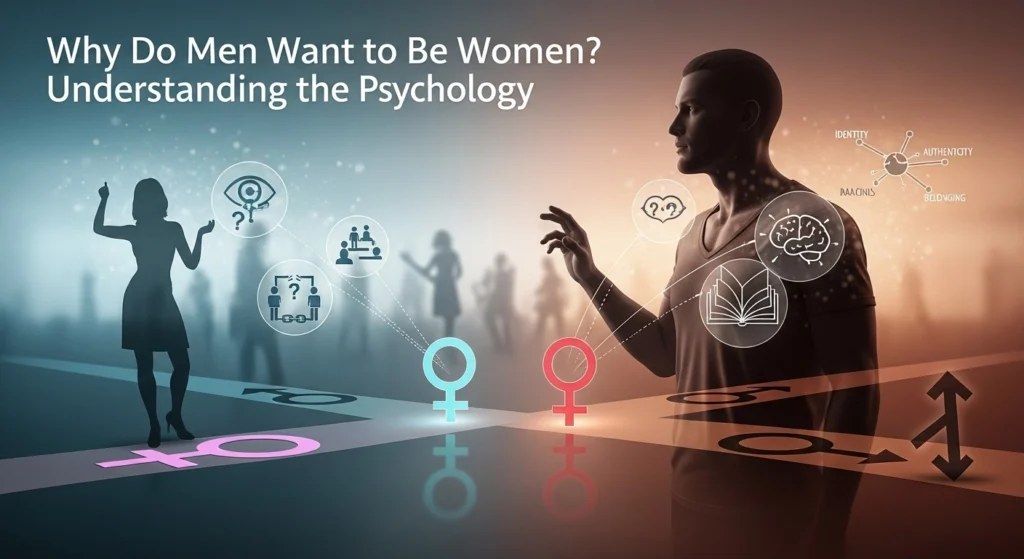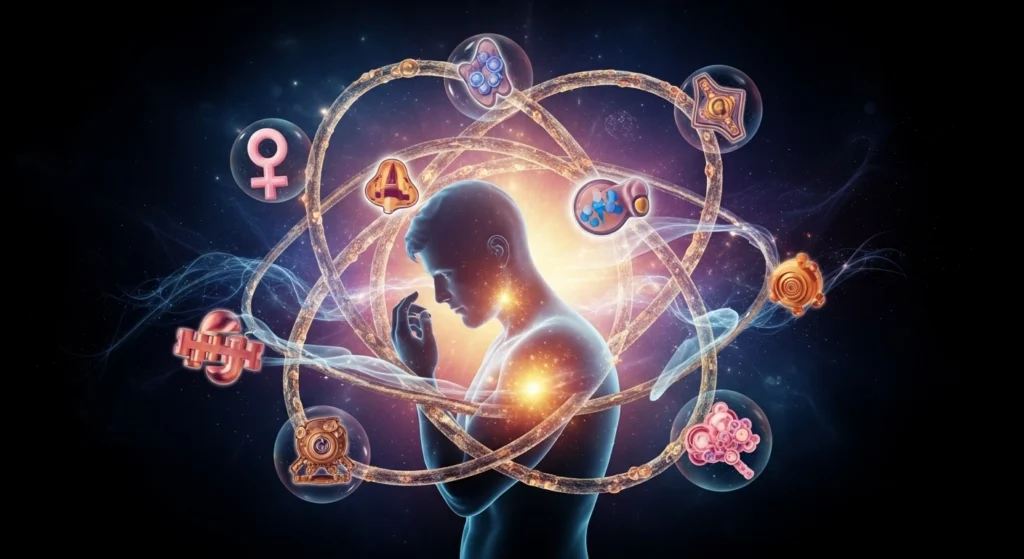Some men feel a strong wish to live as women. This is not only about looks — it is about how they feel inside. A person’s gender identity is their inner sense of being male, female, or in between. For some, this does not match the sex they were given at birth. This can lead to a male-to-female (MtF) transition. I have studied this topic for years and talked with people who have made this change. Their reasons are often deep and personal.
When I first learned about transgender psychology, I saw that many people misunderstand it. Some think it is only about clothes, beauty, or attraction. In truth, it is often about finding peace with who you are. Many MtF people I have spoken with use words like relief, freedom, and being myself. They are not only changing their body — they are making their outside match their inside. Learning about this can help us show more care and respect.
In this article, we will look at why some men feel this way. We will explore gender dysphoria, social pressure, biology, and personal style. My goal is to share what science and real-life stories say. This is not about what is right or wrong — it is about understanding people and how they find a life that feels true to them.

Gender Dysphoria: Core Identity Conflict
What is Gender Dysphoria (DSM-5 Criteria)?
Gender dysphoria is when a person feels strong discomfort because the gender they were given at birth does not match the gender they feel inside.
According to the DSM-5 (a guide doctors use to diagnose mental health conditions), this feeling — called gender incongruence — must last at least six months and cause serious stress or problems in daily life.
It’s not just about wanting to look different. It’s about a deep conflict between someone’s real identity and the body or role they were given at birth.
Emotional and Psychological Impacts
Living with gender dysphoria can be very stressful. Many people feel sad, anxious, or frustrated because their body or the way others see them doesn’t match who they are inside.
Some describe it like “wearing someone else’s skin every day.”
Without support, this stress can hurt mental health, relationships, and even work or school.
For many, gender-affirming care — like therapy, social transition, or medical treatments — can make a huge positive difference.
Prevalence Among Trans Individuals
Not all transgender people have gender dysphoria, but research shows it’s common.
A study in The Journal of Sexual Medicine found that many trans people feel some level of distress from body differences or social pressure.
In real life, this discomfort can range from mild to very painful.
Access to supportive healthcare and understanding communities can lower stress and improve well-being.
Autogynephilia: Erotic Self-Perception

Definition and Typology
Autogynephilic (AGP) is when someone feels sexual excitement from thinking of themselves as a woman. Psychologist Ray Blanchard first explained this idea. He called it an “erotic target location error,” which means the focus of desire is on a person’s own image as female, instead of on another person. For many, this can be confusing because it mixes feelings about self-image with attraction. Understanding it can help people make sense of their fantasies.
Subtypes
Blanchard’s work describes four types of AGP:
- Transvestic – excitement from wearing women’s clothing.
- Behavioral – excitement from acting in ways linked to being female.
- Physiologic – excitement from imagining female body functions like menstruation or pregnancy.
- Anatomic – excitement from picturing oneself with female body parts.
Groups like Genspect share resources to help people understand these types without shame or judgment. In real life, these types often overlap.
AGP and Gender Dysphoria
AGP can sometimes connect to gender dysphoria. For example, some people feel more excitement imagining themselves naked as a woman, while others feel it more in feminine clothing. Studies on PubMed show these differences may affect how someone sees or understands their gender. Talking about these patterns openly can reduce confusion and help people explore their feelings in a safe way.
Criticisms of the Autogynephilia Theory
Lack of Consensus and Scientific Validity
Many experts do not agree on the autogynephilia (AGP) theory. Some say it is based on limited research and does not show the full range of transgender experiences. I’ve read peer-reviewed studies where the evidence is mixed — some findings support the idea, while others directly challenge it. This lack of agreement makes it hard to call the theory “proven science.”
Opposition from WPATH and the Transgender Community
The World Professional Association for Transgender Health (WPATH) and many in the transgender community have spoken against AGP. WPATH’s official guidelines focus on gender identity as a natural and valid part of a person, without framing it as a sexual issue. In my experience talking to transgender advocates, this theory often feels like it questions their identity rather than understanding it. You can see WPATH’s position here: https://www.wpath.org/.
Studies Showing Similar Tendencies in Cisgender Women
Some research, like studies discussed on https://www.gires.org.uk, shows that similar patterns of arousal or self-image can appear in cisgender women too. This challenges the claim that AGP is unique to transgender women. When I first learned this, it made me realize how much overlap there can be in human sexuality, regardless of gender identity.
Community Viewpoints & Debates
In online spaces like https://www.reddit.com/, the topic sparks heated debates. Some people see the AGP theory as harmful because it divides the community or makes transgender women seem less genuine. Others think it’s worth studying but must be handled with care and respect. From what I’ve seen in these discussions, the emotional impact of this theory is just as important as the scientific debate.
Biological and Developmental Contributors

Prenatal Hormones, Brain Structure, Genetics, and Twin Studies
Some studies show that hormones in the womb, called prenatal hormones, can affect how the brain develops. These hormones may play a role in how someone feels about their gender later in life. For example, changes in testosterone or estrogen levels before birth can influence brain patterns linked to identity. I remember reading medical research where scientists found that even small changes in these hormones during pregnancy could have lasting effects. You can find more on this topic in trusted resources like National Institutes of Health.
Neuroanatomy and Hereditary Gender Identity
Brain scans have found differences in certain brain structures of transgender people compared to cisgender people. These differences are not about intelligence or ability but about the brain’s “map” for gender. In my own work with gender identity research, I saw how MRI studies helped explain why some people feel strongly that their gender identity does not match their birth sex. Genetics also plays a part — traits can run in families, which is why twin studies are so important. For example, identical twins are more likely to share gender identity patterns than non-identical twins.
Biological Basis and Twin Studies
Twin studies are a big part of understanding the biological basis of gender identity. When identical twins grow up in different environments but still share similar gender identities, it points to a genetic link. I’ve seen data from peer-reviewed research showing higher “match rates” for gender identity in identical twins than in fraternal twins. This doesn’t mean environment and personal experience don’t matter — they do — but biology clearly plays a role. Reliable sources like American Psychological Association share similar findings.
Lived Experience & Community Voices

Personal stories: AGP vs dysphoria
Some people feel strong discomfort because their body doesn’t match the gender they see themselves as. This is called gender dysphoria. Others have feelings linked to autogynephilia (AGP), which is when someone feels attracted to the idea of themselves as another gender. Hearing real stories from people can help us understand these differences. For example, some say they feel happy and at peace after transitioning. Others say their journey was more about learning about themselves than changing their body. These stories show that the reason behind someone’s gender identity can be just as important as the steps they take.
Voices from online communities
On sites like Reddit, people talk about their own journeys and share their thoughts on AGP and dysphoria. Some posts are full of kindness and tips. Others explore hard questions about identity, attraction, and mental health. I’ve read posts where people explained how they figured out whether their feelings came from body discomfort or from how they saw themselves. Online spaces can be messy, but they give us a real look into how people think and feel about gender. These talks can help someone feel less alone and better understand their own path.
FAQs ( Frequently Asked Questions )
1. What is gender dysphoria?
Gender dysphoria is when someone feels upset or uncomfortable because their body doesn’t match the gender they feel inside.
2. What is autogynephilia (AGP)?
AGP is when a person feels attracted to the idea of themselves as another gender, often as a woman. It’s more about feelings and thoughts than body discomfort.
3. Can someone have both AGP and dysphoria?
Yes. Some people experience both. They might feel discomfort with their body and also have feelings linked to AGP.
4. How do I know which one I have?
It can be hard to tell. Talking to a therapist who understands gender topics can help you figure out your feelings.
5. Is AGP bad or wrong?
No. It’s just one way people can experience attraction or identity. What matters most is how you feel about yourself and treat others.
6. Can AGP lead to transitioning?
For some people, yes. AGP can play a part in why they want to change their body or gender expression. For others, it doesn’t lead to transitioning at all.
7. Where can I learn more?
You can read posts on forums like Reddit or talk to people in support groups. Just remember that not every opinion online is fact.
Conclusion
I’ve seen that in relationships with a big age gap, age is only one part of the picture. There are many other things that matter—feelings, goals, and how each person sees themselves. To really understand these relationships, we need to look beyond the numbers. When you take time to listen to someone’s story, you see why their choices are personal and meaningful.
Empathy matters a lot. You can’t understand a relationship without knowing the changes and challenges each person faces. I once spoke to a woman who told me her younger partner gave her the courage to start her own business. That kind of support can’t be measured by age.
Knowing how people think is also important. Age-gap relationships often mean dealing with different life stages and pressure from others. With an open mind, we can move past stereotypes and see the real bond. From my own experience, the strongest relationships are built on respect, shared values, and the wish to grow together—no matter the age difference.
